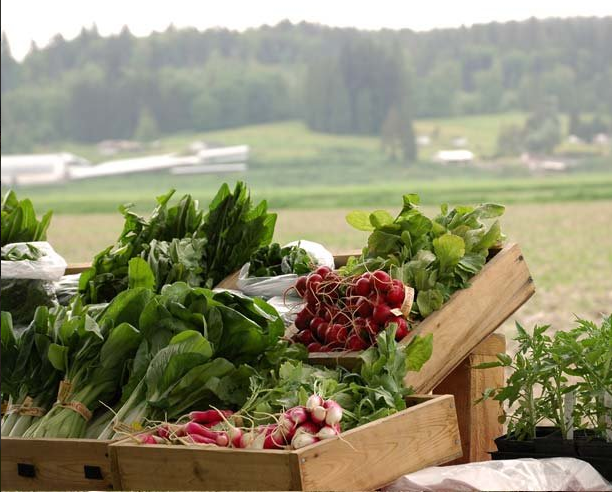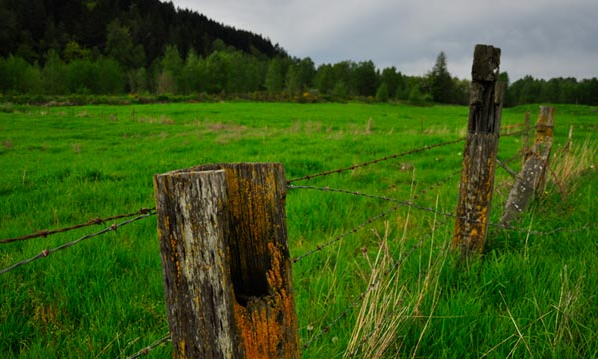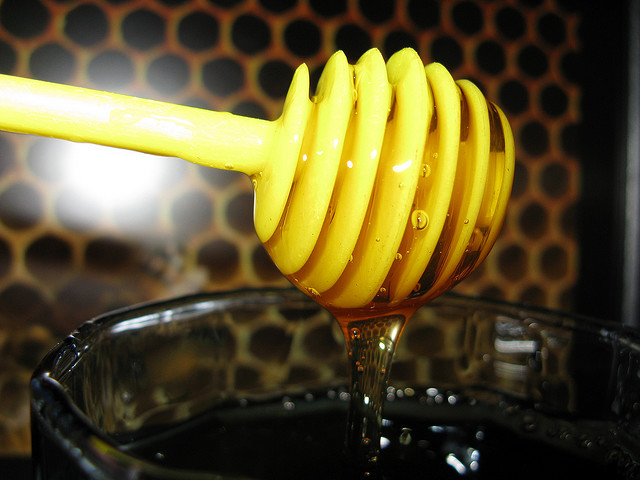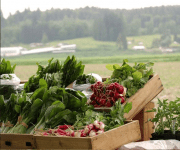 Photo: Alicia Guy Joel Huesby comes from a long line of conventional farmers, but in 1994, he had what he calls an epiphany that led him to switch to organic farming. He’s of the mind that we’ll drive ourselves to extinction if we drive our farmlands that way first. “Conventional commodity agriculture, to my way of looking at it, is standing in the boots of a dead man with toothpicks holding his eyes open,” he said. “It looks alive but it’s not. I don’t see that as the future.”
Photo: Alicia Guy Joel Huesby comes from a long line of conventional farmers, but in 1994, he had what he calls an epiphany that led him to switch to organic farming. He’s of the mind that we’ll drive ourselves to extinction if we drive our farmlands that way first. “Conventional commodity agriculture, to my way of looking at it, is standing in the boots of a dead man with toothpicks holding his eyes open,” he said. “It looks alive but it’s not. I don’t see that as the future.”
Through years of trial and error, Huesby and his family found a way to build their soil and make a living that felt authentic. Then, in 2003, their farm — 225 acres near Walla Walla, Wash. — was threatened by developers looking to subdivide it and convert it to “ranchettes.”
So Huesby put together a binder of information about his property and took it to the PCC Farmland Trust, a nonprofit organization formed in connection to Washington’s Puget Consumers Co-op (PCC), the largest consumer-owned natural food retail co-operative in the United States. The PCC Farmland Trust was able to change the legal status of Huesby’s land, ensuring that it will be “organic and undeveloped into perpetuity.” His was the second farm the PCC Farmland Trust saved from development, but it was far from the last.
Disappearing act
For the 80 percent of Americans who reside in cities, it has become far too easy to take farmland for granted. There’s a great deal of focus on supporting organic, local farmers and making the food they produce accessible to the masses, but these efforts would be fruitless without the farmland itself.
Between 1982 and 2007, over 41 million acres of rural land in the United States were developed. That’s 41 million acres of potentially productive agricultural land gone forever — because once farmland is ripped up, paved over, and developed, you can never get it back, not in the same form.
“We’ve become a little casual about our attitude about farmland,” said Dennis Canty, director of the Pacific Northwest regional office of the American Farmland Trust (AFT). He’s seen the Puget Sound region of Washington lose 60 percent of its farmland since 1950. Much of the loss occurs around the edges of cities and towns, where the qualities that make land ideal for farming — like being located in a broad, flat valley — also catch developers’ eyes. Suburban development gobbles up para-urban farmland, while land farther out turns into hobby farms or weekend retreats for city dwellers.
For farmers fighting to stay afloat — especially aging ones who don’t have a willing next generation waiting to take over — offers from developers can be hard to refuse.
That’s where farmland trusts come in. Rebecca Sadinsky, head of the PCC Farmland Trust, explains how the group raises funds to buy rural land and put it under something called a “conservation easement.” Easements legally dictate that the land must forever be used for agricultural purposes, no matter whether it changes hands. “We’ve essentially taken the speculation out of the land,” Sadinsky says. “It can still rise and fall in value as raw land, but it’s raw ag land.” That way, farmers can rest assured that even when they can’t farm anymore, the soil they’ve put so much sweat and tears into will not be paved over.
That’s the basic model practiced by most land trusts (there are 1,700 nationwide, according to the Land Trust Alliance). Not all work to conserve farmland, specifically: One of the oldest and most well-known trusts is the Nature Conservancy, which focuses primarily on saving natural habitat and wilderness, but served as a model for farmland trusts. “The movement to conserve land didn’t start with farmland,” Sadinsky says. But once the threat to agricultural land intensified, it was recognized as a resource worth conserving.
 Photo: Alicia Guy, courtesy of PCC Farmland TrustThis land is your land, this land is my land
Photo: Alicia Guy, courtesy of PCC Farmland TrustThis land is your land, this land is my land
In the late 1970s and early ‘80s, Canty says, “people could look around and see the land changing right around them.” AFT was founded in 1980; the Vermont Land Trust, which Sadinsky identified as a leader in farmland preservation, started in 1977.
PCC Farmland Trust is unique in that it conserves land specifically for organic farming. “We’d love for everyone to move toward at least more reduction of pesticides,” Sadinsky said, for reasons of water quality alone — not to mention the skyrocketing demand for organic food. But she acknowledges that getting organic certification can be a convoluted and costly process — and she emphasizes the importance of solidarity within the small farm community. “We’ll look for every opportunity to make the argument [for organic farming], without speaking against family farmers who are conventional farmers,” she says.
Farmland trusts have been successful and popular so far. But it’s nearly impossible to save farmland as fast as it’s disappearing — at a rate of more than an acre every minute, according to the AFT.
“These land trusts might pick up 100 or 300 or even 1,000 acres of conservation easements in a year,” Canty says. “But at that rate we’re going to end up with little museum-like farms scattered around the largely suburban landscape.”
So PCC Farmland Trust tries to secure footholds in key areas in the hopes that they will encourage the growth of more agriculture nearby. But support from local, state, and federal government is crucial to conservation efforts. “If you don’t have the political support to protect farmland through regulation, there’s no way you could overcome those shortcomings with funding of conservation easements,” adds Canty.
A model county
Canty and Sadinsky both point to Skagit County — north of Seattle’s King County — as an example of a local government that’s approaching farmland conservation right. Skagit has a local property tax that goes directly to acquisition of conservation easements, as well as a staff dedicated to farmland conservation. Their Farmland Legacy Program reviews applications twice a year from farmers whose land is in need of protection. So far they’ve saved well over 7,000 acres, said Carolyn Kelly, chair of the Conservation Future Advisory Committee, which administers the program. It’s gotten so popular that they have a waiting list.
Kelly credits popular support among voters for the continued success of the program. It was created after a survey showed that Skagitonians — whose county has long been rural, with a “natural resource-based economy” — have a high interest in preserving farmland. “It’s a total community effort,” Kelly says. “I think that’s why we’re still going strong.”
Even in traditionally agricultural communities, the draw of development is strong. “We see agricultural production as the highest and best use of these lands,” Kelly said. “Someone else might see industry or housing. With economic downturns, there is increasing pressure. Somebody offers you enough money, you’re going to think really hard about it. We like to be there to offer an option.”
Organic farms = greener spaces
Conserving farmland has benefits beyond just agricultural potential, too. Urban and suburban land results in much more stormwater runoff, which is full of nasty toxins. In addition, “an awful lot of the intact habitat for fish and wildlife species is found on farms,” Canty says. “Many of the best restoration opportunities are there.”
Kelly agrees. “You get a lot of bang for your buck. We’ve preserved the rural character of Skagit County. Even if you’re just passing through, you get a sense of who we are and what we do.”
All this forward momentum toward protecting farmland could be threatened, though, if the 2012 Farm Bill doesn’t take farmland into account. Part of the last bill, the Farm and Ranch Lands Protection Program, provided matching grants for the purchase of development rights. “We’re trying to … avoid really dire cuts in the conservation programs,” Canty said. “We know we’re going to lose some ground, but we’ll just try not to lose it all.”
“I think you could look at food security as just as important as homeland security,” Kelly adds. “I want to have access to wholesome foods [grown here]. I don’t want to have to wait until it comes in from some other country.”
With just about everything sustainable farmers and eaters hold sacred threatened by budget cuts, farmland doesn’t necessarily come to mind as the most important thing on the chopping block — especially not for urbanites. But without enough farmland, “we can pretty much kiss this idea of local food good-bye,” said Canty.




